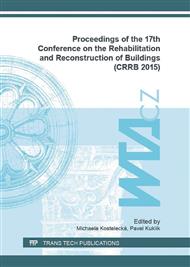[1]
Li Z., Advanced Concrete Technology, (2011), 506 p, doi: 10. 1002/9780470950067.
Google Scholar
[2]
Vodička J., Veselý V. Krátký J., Specifics of fiber concrete technology, Beton TSK, 10 (2010) 2, ISSN 12133116.
Google Scholar
[3]
Vikrant S. Vairagade, Kavita S. Kene, Introduction to steel fiber reinforced concrete on engineering performance of concrete, International journal of scientific & technology research, 1 (2012) 4, ISSN 2277-8616.
Google Scholar
[4]
Lataste J. F., Behloul M., Breysse D., Characterisation of fibres distribution in a steel fibre reinforced concrete with electrical resistivity measurements, NDT & E International, 41 (2008) 8, 638-647, doi: 10. 1016/j. ndteint. 2008. 03. 008.
DOI: 10.1016/j.ndteint.2008.03.008
Google Scholar
[5]
Stähli P., G. M. van Mier J., Manufacturing, fibre anisotropy and fracture of hybrid fibre concrete, Engineering Fracture Mechanics, 74 (2007) 1-2, 223-242, doi: 10. 1016/j. engfracmech. 2006. 01. 028.
DOI: 10.1016/j.engfracmech.2006.01.028
Google Scholar
[6]
Martinie L., Roussel N., Simple tools for fiber orientation prediction in industrial practice, Cement and concrete research, 41 (2011) 10, 993-1000, doi: 10. 1016/j. cemconres. 2011. 05. 008.
DOI: 10.1016/j.cemconres.2011.05.008
Google Scholar
[7]
Dvorkin L., Dvorkin O., Yhitkovskz V., Ribakov Y., A method for optimal design of steel fiber reinforced concrete composition, Materials and Design, 32 (2011) 6, 3254-3262, doi: 10. 1016/ j. matdes. 2011. 02. 036.
DOI: 10.1016/j.matdes.2011.02.036
Google Scholar
[8]
Shah A. A., Ribakov Y., Recent trends in steel fibered high-strength concrete, Materials and Design, 32 (2011) 8-9, 4122-4151, doi: 10. 1016/j. matdes. 2011. 03. 030.
DOI: 10.1016/j.matdes.2011.03.030
Google Scholar
[9]
Fiala,P., Drexler,P., Nespor,D. A resonance-based solar element: a numerical model and micro/nano technology application, Proc. SPIE 8763, Smart Sensors, Actuators, and MEMS VI, 87632A (2013); doi: 10. 1117/12. 2015111.
DOI: 10.1117/12.2015111
Google Scholar
[10]
Kelly P., Electricity and magnetism. Boca Raton, Fla.: CRC Press, (2015), 404, ISBN 1482206358.
Google Scholar
[11]
Fiorillo F., Measurement and characterization of magnetic materials, 1st ed. Amsterdam: Elsevier Academic Press, (2004). ISBN 9780080528922.
Google Scholar
[12]
Valenzuela R., Magnetic ceramics. New York: Cambridge University Press, (1994), 312, ISBN 052136485.
Google Scholar
[13]
Bowick Ch., RF circuit design. 2nd ed. London: Newnes, (2008), 243.
Google Scholar
[14]
Callegaro L., Electrical impedance: principles, measurement, and applications, Boca Raton: CRC Press, (2013), 284, ISBN 1439849102.
Google Scholar


